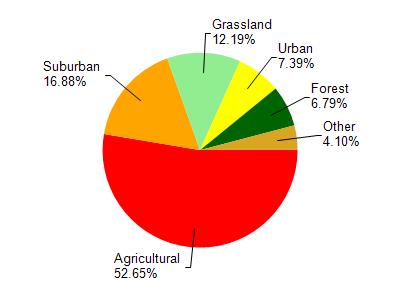Calumet, Outagamie
No
No
Yes
Fish and Aquatic Life
Overview
Kankapot Creek, is a 9-mile stream with poor water quality. Stream habitat was rated poor to fair. The heavy clay soils that cover the stream bottom provide very little habitat for fish and other aquatic life. Pools are generally filled in and riffles are uncommon. The streambanks are eroded and slumping in many places, due to flooding. Gully erosion is common from roadway drainages. Macroinvertebrate samples indicate poor to fair water quality, very significant to significant organic pollution. Lack of suitable habitat is the most significant limiting factor for abundance and diversity of macroinvertebrates in this stream. Kankapot Creek receives a considerable amount of nutrients, suspended solids and bacteria as indicated by the high concentrations during runoff sampling periods (Gansberg 1995).
Bougie, Cheryl A. 1999. Lower Fox River Basin Water Quality Management Plan. Public Review Draft. Wisconsin Department of Natural Resources, Madison, WI.
Date 1999
Author Cheryl Bougie
Historical Description
Kaukapot Creek, T21N, R18E, Sec. 24(6), Area = 0.5 acres, Length = 3.9 miles, M.P.A. = 116 ppm,
Gradient = 12.8 feet/mile.
Only a small trickle of water was present in this stream on the day of investigation. The water is
clear and hard; however, the specific conductance is excessive, indicating the presence of contaminants.
Bedrock is the bottom material of this stream throughout much of Outagamie County. The banks consist of
walls built from bedrock slabs. There is no cover, aquatic invertebrates, or fishery. Access is limited
to one town road, and street crossings.
From: Nelson, Linden M. and Ronald L. Fassbender. Surface Water Resources of Outagamie County:
Lake and Stream Classification Project. Wisconsin Department of Natural Resources, Madison, WI.
Date 1972
Author Surface Water Inventory Of Wisconsin
Impaired Waters
Kankapot Creek was put on the Impaired Waters Lists in the 1998 cycle for sediment and degraded habitat. Phosphorus and degraded biology were added during the 2008 cycle. This water is part of the Lower Fox River TP & TSS TMDL that was approved by the EPA in 2012. Evaluations every two-year cycle from 2014 to 2022 confirmed the phosphorus impairment.
Date 2022
Author Ashley Beranek
Condition
Wisconsin has over 84,000 miles of streams, 15,000 lakes and milllions of acres of wetlands. Assessing the condition of this vast amount of water is challenging. The state's water monitoring program uses a media-based, cross-program approach to analyze water condition. An updated monitoring strategy (2015-2020) is now available. Compliance with Clean Water Act fishable, swimmable standards are located in the Executive Summary of Water Condition in 2018. See also the 'monitoring and projects' tab.
Reports
Management Goals
Wisconsin's Water Quality Standards provide qualitative and quantitative goals for waters that are protective of Fishable, Swimmable conditions [Learn more]. Waters that do not meet water quality standards are considered impaired and restoration actions are planned and carried out until the water is once again fishable and swimmable
Management goals can include creation or implementation of a Total Maximum Daily Load analysis, a Nine Key Element Plan, or other restoration work, education and outreach and more. If specific recommendations exist for this water, they will be displayed below online.
Monitoring
Monitoring the condition of a river, stream, or lake includes gathering physical, chemical, biological, and habitat data. Comprehensive studies often gather all these parameters in great detail, while lighter assessment events will involve sampling physical, chemical and biological data such as macroinvertebrates. Aquatic macroinvertebrates and fish communities integrate watershed or catchment condition, providing great insight into overall ecosystem health. Chemical and habitat parameters tell researchers more about human induced problems including contaminated runoff, point source dischargers, or habitat issues that foster or limit the potential of aquatic communities to thrive in a given area. Wisconsin's Water Monitoring Strategy was recenty updated.
Grants and Management Projects
Monitoring Projects
| WBIC | Official Waterbody Name | Station ID | Station Name | Earliest Fieldwork Date | Latest Fieldwork Date | View Station | View Data |
|---|
| 126800 | Kankapot Creek | 10016668 | Kankapot Creek - Upstream Of Cth Kk Bridge | 4/7/1992 | 9/28/2015 | Map | Data |
| 126800 | Kankapot Creek | 10015578 | Kankapot Creek - Upstream Of Kk | | | Map | Data |
| 126800 | Kankapot Creek | 453276 | Kankapot Creek - Near Kaukauna WI | 6/19/2001 | 10/16/2001 | Map | Data |
|

Watershed Characteristics
Kankapot Creek is located in the Plum and Kankapot Creeks watershed which is 84.04 mi². Land use in the watershed is primarily agricultural (52.70%), suburban (16.90%) and a mix of grassland (12.20%) and other uses (18.30%). This watershed has 193.77 stream miles, 39.36 lake acres and 1,129.50 wetland acres.
Nonpoint Source Characteristics
This watershed is ranked High for runoff impacts on streams, Not Available for runoff impacts on lakes and High for runoff impacts on groundwater and therefore has an overall rank of High. This value can be used in ranking the watershed or individual waterbodies for grant funding under state and county programs.However, all waters are affected by diffuse pollutant sources regardless of initial water quality. Applications for specific runoff projects under state or county grant programs may be pursued. For more information, go to surface water program grants.